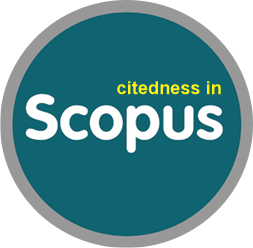Model Persamaan Struktural Mengekspolarasi Jalur Path Kepemimpinan Transformasional dan Motivasi Terhadap Kinerja Pegawai TAF
DOI:
https://doi.org/10.32493/JJSDM.v5i2.16506Keywords:
Kepemimpinan Transformasional, Kinerja Pegawai, MotivasiAbstract
Penelitian ini bertujuan untuk melihat pengaruh kepemimpinan transformasional dan motivasi kerja terhadap kinerja pegawai. Metode yang digunakan dalam penelitian ini adalah metode kuntitatif verifikatif. Instumen yang digunakan adalah kuesioner yang berjumlah 15 pernyataan yang diberikan kepada 60 orang karyawan TAF. Pengambilan sampel dilakukan dengan teknik aksidental (convenient sampling). Data penelitian dianalisis dengan menggunakan Smart PLS versi 3.0. Hasil penelitian menunjukkan bahwa kepemimpinan transformasional berpengaruh signifikan terhadap kinerja pegawai (p<0,05), motivasi kerja tidak berpengaruh signifikan terhadap kinerja pegawai (p>0,05), dan kepemimpinan transformasional yang dimediasi oleh motivasi tidak berpengaruh signifikan terhadap kinerja pegawai (p>0,05). Penelitian lanjutan diharapkan dapat membuat suatu model peningkatan kepemimpinan transformasional yang dapat meningkatkan motivasi dan kinerja pegawai.References
Ali, A., Bin, L. Z., Piang, H. J., & Ali, Z. 2016. The Impact of Motivation on the Employee Performance and Job Satisfaction in IT Park (Software House) Sector of Peshawar, Pakistan. International Journal of Academic Research in Business and Social Sciences, 6(9), 297–310. https://doi.org/10.6007/ijarbss/v6-i9/2311
Andriani, S., Kesumawati, N., & Kristiawan, M. 2018. The influence of the transformational leadership and work motivation on teachers performance. International Journal of Scientific and Technology Research, 7(7), 19–29.
Bass, B. M., Avolio, B. J., Jung, D. I., & Berson, Y. 2003. Predicting unit performance by assessing transformational and transactional leadership. Journal of Applied Psychology. https://doi.org/10.1037/0021-9010.88.2.207
Bernardin, H. J., & Russel, J. E.1993. Human Resourses management. New York: Mc Graw Hill Inc.
Gonnah, B. J., & Ogollah, K. 2016. Effect of Transformational Leadership on Performance of Commercial Banks in Kenya: Case of Family Bank Limited. International Academic Journal of Innovation, Leadership and Entrepreneurship, 2(1), 1–25. Retrieved from http://www.iajournals.org/articles/iajile_v2_i1_1_25.pdf
Hope, O. K., & Vyas, D. 2017. Private company finance and financial reporting. Accounting and Business Research. https://doi.org/10.1080/00014788.2017.1303963
Jha, S., & Malviya, V. 2017. Impact of transformational leadership on employee engagement. Pranjana:The Journal of Management Awareness, 20(2), 15. https://doi.org/10.5958/0974-0945.2017.00011.5
Keegan, A. E., & Den Hartog, D. N. 2004. Transformational leadership in a project-based environment: A comparative study of the leadership styles of project managers and line managers. International Journal of Project Management, 22(8), 609–617. https://doi.org/10.1016/j.ijproman.2004.05.005
Martani, D., & Munaiseche, R. R. 2010. Factors affecting profitability of multi-finance company in Indonesia, 9(5), 53–63.
Muda, I., Rafiki, A., & Harahap, M. R. 2014. Factors Influencing Employees ’ Performance : A Study on the Islamic Banks in Indonesia. International Journal of Business and Social Sience, 5(2), 73–80.
Muller, D., & Judd, C. M. 2014. Direct and Indirect Effects. In Wiley StatsRef: Statistics Reference Online. https://doi.org/10.1002/9781118445112.stat06589
Nugroho, G. S., & Havidz Aima, M. 2018. The Influences Of Transformational Leadership And Compensation To Employee Performance On Their Motivation And The Implementation At X Institution. International Journal of Scientific and Research Publications (IJSRP), 8(12). https://doi.org/10.29322/ijsrp.8.12.2018.p8447
Omolo, P. A. 2015. Effect of motivation on employee performance of commercial banks in Kenya: A case study of Kenya Commercial Bank in Migori County. International Journal of Human Resource Studies, 5(2), 87. https://doi.org/10.5296/ijhrs.v5i2.7504
Osabiya, B. J. 2015. The effect of employees motivation on organizational performance. Journal of Public Administration and Policy Research. https://doi.org/10.5897/jpapr2014.0300
Pardee, R. 1990. Motivation Theories of Maslow, Herzberg, McGregor & McClelland. A Literature Review of Selected Theories Dealing with Job Satisfaction and Motivation. Synopsis of Selected Motivational Theories.
Prajogo, D. I. 2007. The relationship between competitive strategies and product quality. Industrial Management and Data Systems, 107(1), 69–83. https://doi.org/10.1108/02635570710719061
Priyanto, W. B. 2016. Pengaruh Gaya Kepemimpinan Kinerja Karyawan Dengan Motivasi Sebagai, 07(02), 105–114.
Putra, A. K., & Frianto, A. 2018. Pengaruh Motivasi Intrinsik dan Motivasi Ekstrinsik terhadap Kepuasan Kerja. BISMA (Bisnis Dan Manajemen). https://doi.org/10.26740/bisma.v6n1.p59-66
Schwab, K. 2016. The Fourth Industrial Revolution: what it means and how to respond. World Economic Forum.
Shahzadi, I., Javed, A., Pirzada, S. S., Nasreen, S., & Khanam, F. 2014. Impact of Employee Motivation on Employee Performance. European Journal of Business and ManagementOnline), 6(23), 2222–2839.
Sugiyono. 2011. Metode Penelitian Kuantitatif, Kualitatif dan R&D. Bandung: Afabeta
Tabassi, A. A., Ramli, M., & Dashti, K. F. 2014. Transformational Leadership and Team Effectiveness in the Construction Industry. Strategic Leadership Review, 3(4).
Vosloban, R. I. 2012. The Influence of the Employee’s Performance on the Company’s Growth - A Managerial Perspective. Procedia Economics and Finance, 3(12), 660–665. https://doi.org/10.1016/s2212-5671(12)00211-0.
Downloads
Published
Issue
Section
License
Authors who publish in this journal agree to the following terms:
The author owns the copyright of the article and assigns to the journal the right of first publication with the work simultaneously licensed under the terms Atribusi 4.0 Internasional (CC BY 4.0)
 which allows others to share the work with acknowledgment of the work's authorship and initial publication in this journal.
which allows others to share the work with acknowledgment of the work's authorship and initial publication in this journal.Authors may enter into separate additional contractual arrangements for the non-exclusive distribution of the published journal version of the work (for example, posting it to an institutional repository or publishing it in a book), with acknowledgment of the work's original publication in this journal.
Authors are permitted and encouraged to post their work online (for example, in institutional repositories or on their websites) before and during the submission process, as this can lead to productive exchanges, as well as earlier and larger citations of published work (See The Effect of Open Access).






























.png)





